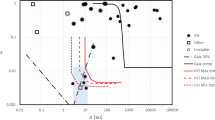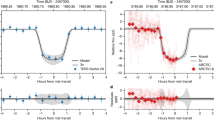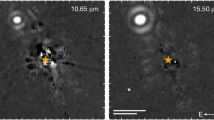Abstract
The formation and early evolution of Jupiter played a pivotal role in sculpting the large-scale architecture of the Solar System, intertwining the narrative of Jovian early years with the broader story of the Solar System’s origins. The details and chronology of Jupiter’s formation, however, remain elusive, primarily due to the inherent uncertainties of accretionary models, highlighting the need for independent constraints. Here we show that, by analysing the dynamics of Jupiter’s satellites concurrently with its angular-momentum budget, we can infer Jupiter’s radius and interior state at the time of the protosolar nebula’s dissipation. In particular, our calculations reveal that Jupiter was 2 to 2.5 times as large as it is today, 3.8 Myr after the formation of the first solids in the Solar System. Our model further indicates that young Jupiter possessed a magnetic field of B♃† ≈ 21 mT (a factor of ~ 50 higher than its present-day value) and was accreting material through a circum-Jovian disk at a rate of \(\dot{M}=1.2\)–2.4 M♃ Myr−1. Our findings are fully consistent with the core-accretion theory of giant-planet formation and provide an evolutionary snapshot that pins down properties of the Jovian system at the end of the protosolar nebula’s lifetime.
This is a preview of subscription content, access via your institution
Access options
Access Nature and 54 other Nature Portfolio journals
Get Nature+, our best-value online-access subscription
$32.99 / 30 days
cancel any time
Subscribe to this journal
Receive 12 digital issues and online access to articles
$119.00 per year
only $9.92 per issue
Buy this article
- Purchase on SpringerLink
- Instant access to full article PDF
Prices may be subject to local taxes which are calculated during checkout


 .
.
Similar content being viewed by others
Data availability
ASCII MESA output files summarizing the interior profiles shown in Fig. 2 are available for download at https://www.konstantinbatygin.com/jupiter.
Code availability
This work utilizes the MESA stellar evolution code, publicly available at https://docs.mesastar.org/.
References
Poincaré, H. Les Méthodes Nouvelles de la Mécanique Céleste (Gauthier-Villars, 1892).
Arnol’d, V. I. Small denominators and problems of stability of motion in classical and celestial mechanics. Russ. Math. Surv. 18, 85–191 (1963).
Celletti, A. & Chierchia, L. On the stability of realistic three-body problems. Commun. Math. Phys. 186, 413–449 (1997).
Walsh, K. J., Morbidelli, A., Raymond, S. N., O’Brien, D. P. & Mandell, A. M. A low mass for Mars from Jupiter’s early gas-driven migration. Nature 475, 206–209 (2011).
Batygin, K. & Laughlin, G. Jupiter’s decisive role in the inner Solar System’s early evolution. Proc. Natl Acad. Sci. USA 112, 4214–4217 (2015).
Kruijer, T. S., Burkhardt, C., Budde, G. & Kleine, T. Age of Jupiter inferred from the distinct genetics and formation times of meteorites. Proc. Natl Acad. Sci. USA 114, 6712–6716 (2017).
Helled, R. et al. Revelations on Jupiter’s formation, evolution and interior: challenges from Juno results. Icarus 378, 114937 (2022).
Guillot, T. et al. in Protostars and Planets VII (eds Inutsuka, S.-i. et al.) 947 (Astronomical Society of the Pacific, 2023).
Miguel, Y. et al. Jupiter’s inhomogeneous envelope. Astron. Astrophys. 662, A18 (2022).
Howard, S. et al. Exploring the hypothesis of an inverted Z gradient inside Jupiter. Astron. Astrophys. 680, L2 (2023).
Militzer, B. & Hubbard, W. B. Study of Jupiter’s interior: comparison of 2, 3, 4, 5, and 6 layer models. Icarus 411, 115955 (2024).
Mizuno, H. Formation of the giant planets. Prog. Theor. Phys. 64, 544–557 (1980).
Stevenson, D. J. Formation of the giant planets. Planet. Space Sci. 30, 755–764 (1982).
Bodenheimer, P. & Pollack, J. B. Calculations of the accretion and evolution of giant planets: the effects of solid cores. Icarus 67, 391–408 (1986).
Pollack, J. B. et al. Formation of the giant planets by concurrent accretion of solids and gas. Icarus 124, 62–85 (1996).
Hubickyj, O., Bodenheimer, P. & Lissauer, J. J. Accretion of the gaseous envelope of Jupiter around a 5–10 Earth-mass core. Icarus 179, 415–431 (2005).
Mordasini, C. Luminosity of young Jupiters revisited. Massive cores make hot planets. Astron. Astrophys. 558, A113 (2013).
D’Angelo, G., Weidenschilling, S. J., Lissauer, J. J. & Bodenheimer, P. Growth of Jupiter: formation in disks of gas and solids and evolution to the present epoch. Icarus 355, 114087 (2021).
Helled, R. The mass of gas giant planets: is Saturn a failed gas giant? Astron. Astrophys. 675, L8 (2023).
Stevenson, D. J., Bodenheimer, P., Lissauer, J. J. & D’Angelo, G. Mixing of condensable constituents with H–He during the formation and evolution of Jupiter. Planet. Sci. J. 3, 74 (2022).
Cumming, A., Helled, R. & Venturini, J. The primordial entropy of Jupiter. Mon. Not. R. Astron. Soc. 477, 4817–4823 (2018).
Leconte, J. & Chabrier, G. A new vision of giant planet interiors: impact of double diffusive convection. Astron. Astrophys. 540, A20 (2012).
Burns, J. A. et al. in Jupiter. The Planet, Satellites and Magnetosphere (eds Bagenal, F. et al.) Vol. 1 241–262 (Cambridge Univ. Press, 2004).
Batygin, K. & Morbidelli, A. Formation of giant planet satellites. Astrophys. J. 894, 143 (2020).
Takato, N., Bus, S. J., Terada, H., Pyo, T.-S. & Kobayashi, N. Detection of a deep 3-μm absorption feature in the spectrum of Amalthea (JV). Science 306, 2224–2227 (2004).
Hamilton, D. P., Proctor, A. L. & Rauch, K. P. An explanation for the high inclinations of Thebe and Amalthea. AAS/Division for Planetary Sciences Meeting Abstracts 33 (2001).
Canup, R. M. & Ward, W. R. Formation of the Galilean satellites: conditions of accretion. Astron. J. 124, 3404–3423 (2002).
Ronnet, T. & Johansen, A. Formation of moon systems around giant planets. Capture and ablation of planetesimals as foundation for a pebble accretion scenario. Astron. Astrophys. 633, A93 (2020).
Masset, F. S., Morbidelli, A., Crida, A. & Ferreira, J. Disk surface density transitions as protoplanet traps. Astrophys. J. 642, 478–487 (2006).
Paardekooper, S.-J., Baruteau, C. & Kley, W. A torque formula for non-isothermal Type I planetary migration—II. Effects of diffusion. Mon. Not. R. Astron. Soc. 410, 293–303 (2011).
Ataiee, S. & Kley, W. Pushing planets into an inner cavity by a resonant chain. Astron. Astrophys. 648, A69 (2021).
Batygin, K. On the terminal rotation rates of giant planets. Astron. J. 155, 178 (2018).
Helled, R., Anderson, J. D., Schubert, G. & Stevenson, D. J. Jupiter’s moment of inertia: a possible determination by Juno. Icarus 216, 440–448 (2011).
Wahl, S. M. et al. Comparing Jupiter interior structure models to Juno gravity measurements and the role of a dilute core. Geophys. Res. Lett. 44, 4649–4659 (2017).
Ni, D. Empirical models of Jupiter’s interior from Juno data. Moment of inertia and tidal Love number k2. Astron. Astrophys. 613, A32 (2018).
Lozovsky, M., Helled, R., Rosenberg, E. D. & Bodenheimer, P. Jupiter’s formation and its primordial internal structure. Astrophys. J. 836, 227 (2017).
Vazan, A., Helled, R. & Guillot, T. 2018. Jupiter’s evolution with primordial composition gradients. Astron. Astrophys. 610, L14 (2018).
Valletta, C. & Helled, R. The deposition of heavy elements in giant protoplanetary atmospheres: the importance of planetesimal–envelope interactions. Astrophys. J. 871, 127 (2019).
Spiegel, D. S. & Burrows, A. Spectral and photometric diagnostics of giant planet formation scenarios. Astrophys. J. 745, 174 (2012).
Berardo, D. & Cumming, A. Hot-start giant planets form with radiative interiors. Astrophys. J. 846, L17 (2017).
Marley, M. S., Fortney, J. J., Hubickyj, O., Bodenheimer, P. & Lissauer, J. J. On the luminosity of young Jupiters. Astrophys. J. 655, 541–549 (2007).
Mordasini, C., Marleau, G.-D. & Mollière, P. Characterization of exoplanets from their formation. III. The statistics of planetary luminosities. Astron. Astrophys. 608, A72 (2017).
Berardo, D., Cumming, A., & Marleau, G.-D. The evolution of gas giant entropy during formation by runaway accretion. Astrophys. J. 834, 149 (2017).
Marleau, G.-D., Mordasini, C. & Kuiper, R. The planetary accretion shock. II. Grid of postshock entropies and radiative shock efficiencies for nonequilibrium radiation transport. Astrophys. J. 881, 144 (2019).
Wang, H. et al. Lifetime of the solar nebula constrained by meteorite paleomagnetism. Science 355, 623–627 (2017).
Ghosh, P. & Lamb, F. K. Disk accretion by magnetic neutron stars. Astrophys. J. 223, L83–L87 (1978).
Carvalho, A., Hillenbrand, L. & Seebeck, J. Disk cooling and wind lines as seen in the spectral line evolution of V960 Mon. Astrophys. J. 958, 140 (2023).
Zhu, Z., Stone, J. M. & Calvet, N. A global 3D simulation of magnetospheric accretion—I. Magnetically disrupted discs and surface accretion. Mon. Not. R. Astron. Soc. 528, 2883–2911 (2024).
Christensen, U. R., Holzwarth, V. & Reiners, A. Energy flux determines magnetic field strength of planets and stars. Nature 457, 167–169 (2009).
Christensen, U. R. & Aubert, J. Scaling properties of convection-driven dynamos in rotating spherical shells and application to planetary magnetic fields. Geophys. J. Int. 166, 97–114 (2006).
Mohanty, S. & Shu, F. H. Magnetocentrifugally driven flows from young stars and disks. VI. Accretion with a multipole stellar field. Astrophys. J. 687, 1323–1338 (2008).
Murray, C. D. & Dermott, S. F. Solar System Dynamics (Cambridge Univ. Press, 1999).
Morbidelli, A. Modern Celestial Mechanics: Aspects of Solar System Dynamics (Taylor & Francis, 2002).
Goldstein, H. Classical Mechanics (Addison-Wesley, 1950).
Borderies, N. & Goldreich, P. A simple derivation of capture probabilities for the J + 1:J and J + 2:J orbit–orbit resonance problems. Celest. Mech. 32, 127–136 (1984).
Ferraz-Mello, S. in Canonical Perturbation Theories—Degenerate Systems and Resonance Vol. 345 (Springer, 2007).
Henrard, J. & Lemaitre, A. A second fundamental model for resonance. Celest. Mech. 30, 197–218 (1983).
Batygin, K. & Batygin, Y. K. Chaotic dynamics driven by particle–core interactions. Phys. Plasmas 28, 093104 (2021).
Goldreich, P. & Tremaine, S. Disk–satellite interactions. Astrophys. J. 241, 425–441 (1980).
Crida, A., Morbidelli, A. & Masset, F. On the width and shape of gaps in protoplanetary disks. Icarus 181, 587–604 (2006).
Adams, F. C., Laughlin, G. & Bloch, A. M. Turbulence implies that mean motion resonances are rare. Astrophys. J. 683, 1117–1128 (2008).
Batygin, K. & Adams, F. C. An analytic criterion for turbulent disruption of planetary resonances. Astron. J. 153, 120 (2017).
Wu, Y., Chen, Y.-X. & Lin, D. N. C. Chaotic Type I migration in turbulent discs. Mon. Not. R. Astron. Soc. 528, L127–L132 (2024).
Livio, M. & Pringle, J. E. Dwarf nova outbursts—the ultraviolet delay and the effect of a weakly magnetized white dwarf. Mon. Not. R. Astron. Soc. 259, 23P (1992).
Uzdensky, D. A., Königl, A. & Litwin, C. Magnetically linked star–disk systems. II. Effects of plasma inertia and reconnection in the magnetosphere. Astrophys. J. 565, 1205–1215 (2002).
Matt, S. & Pudritz, R. E. The spin of accreting stars: dependence on magnetic coupling to the disc. Mon. Not. R. Astron. Soc. 356, 167–182 (2005).
Armitage, P. J. & Clarke, C. J. Magnetic braking of T Tauri stars. Mon. Not. R. Astron. Soc. 280, 458–468 (1996).
Helled, R. The change in Jupiter’s moment of inertia due to core erosion and planetary contraction. Astrophys. J. 748, L16 (2012).
Paxton, B. et al. Modules for Experiments in Stellar Astrophysics (MESA): planets, oscillations, rotation, and massive stars. Astrophys. J. Suppl. 208, 4 (2013).
Saumon, D., Chabrier, G. & van Horn, H. M. An equation of state for low-mass stars and giant planets. Astrophys. J. Suppl. 99, 713–741 (1995).
Grevesse, N. & Sauval, A. J. Standard solar composition. Space Sci. Rev. 85, 161–174 (1998).
Freedman, R. S., Marley, M. S. & Lodders, K. Line and mean opacities for ultracool dwarfs and extrasolar planets. Astrophys. J. Suppl. 174, 504–513 (2008).
Chabrier, G., Mazevet, S. & Soubiran, F. A new equation of state for dense hydrogen–helium mixtures. Astrophys. J. 872, 51 (2019).
Saumon, D. & Guillot, T. Shock compression of deuterium and the interiors of Jupiter and Saturn. Astrophys. J. 609, 1170–1180 (2004).
Miguel, Y., Guillot, T. & Fayon, L. Jupiter internal structure: the effect of different equations of state. Astron. Astrophys. 596, A114 (2016).
Mazevet, S., Licari, A. & Soubiran, F. Benchmarking the ab initio hydrogen equation of state for the interior structure of Jupiter. Astron. Astrophys. 664, A112 (2022).
Howard, S. & Guillot, T. 2023. Accounting for non-ideal mixing effects in the hydrogen–helium equation of state. Astron. Astrophys. 672, L1 (2023).
Howard, S. et al. Jupiter’s interior from Juno: equation-of-state uncertainties and dilute core extent. Astron. Astrophys. 672, A33 (2023).
Knierim, H. & Helled, R. Convective mixing in giant planets and the connection to atmospheric measurements. Astrophys. J. 977, 227–240 (2024).
Shu, F. H., Najita, J., Ruden, S. P. & Lizano, S. Magnetocentrifugally driven flows from young stars and disks. II. Formulation of the dynamical problem. Astrophys. J. 429, 797–807 (1994).
Adachi, I., Hayashi, C. & Nakazawa, K. The gas drag effect on the elliptical motion of a solid body in the primordial solar nebula. Prog. Theor. Phys. 56, 1756–1771 (1976).
Szulágyi, J. et al. Circumplanetary disc or circumplanetary envelope? Mon. Not. R. Astron. Soc. 460, 2853–2861 (2016).
Lambrechts, M., Lega, E., Nelson, R. P., Crida, A. & Morbidelli, A. Quasi-static contraction during runaway gas accretion onto giant planets. Astron. Astrophys. 630, A82 (2019).
Krapp, L. et al. A thermodynamic criterion for the formation of circumplanetary disks. Astrophys. J. 973, 153–168 (2024).
Adams, F. C. & Batygin, K. Analytic approach to the late stages of giant planet formation. Astrophys. J. 934, 111 (2022).
Acknowledgements
K.B. is grateful to Caltech, the David and Lucile Packard Foundation and the National Science Foundation (grant number AST 2408867) for their support. F.C.A. is supported in part by the University of Michigan and the Leinweber Center for Theoretical Physics.
Author information
Authors and Affiliations
Contributions
K.B. conceived the project, ran the MESA simulations, and led the writing of the paper. F.C.A. collaborated on the interpretation of the results, provided critical feedback on the methodology, and contributed to writing and revising the paper.
Corresponding author
Ethics declarations
Competing interests
The authors declare no competing interests.
Peer review
Peer review information
Nature Astronomy thanks Ravit Helled and the other, anonymous, reviewer(s) for their contribution to the peer review of this work.
Additional information
Publisher’s note Springer Nature remains neutral with regard to jurisdictional claims in published maps and institutional affiliations.
Supplementary information
Supplementary Information
Supplementary Figs. 1 and 2.
Rights and permissions
Springer Nature or its licensor (e.g. a society or other partner) holds exclusive rights to this article under a publishing agreement with the author(s) or other rightsholder(s); author self-archiving of the accepted manuscript version of this article is solely governed by the terms of such publishing agreement and applicable law.
About this article
Cite this article
Batygin, K., Adams, F.C. Determination of Jupiter’s primordial physical state. Nat Astron 9, 835–844 (2025). https://doi.org/10.1038/s41550-025-02512-y
Received:
Accepted:
Published:
Issue date:
DOI: https://doi.org/10.1038/s41550-025-02512-y



